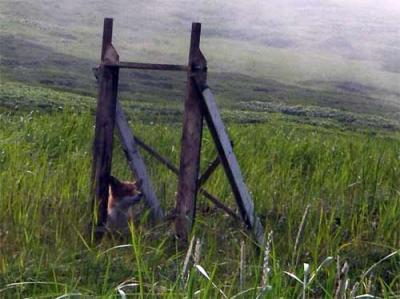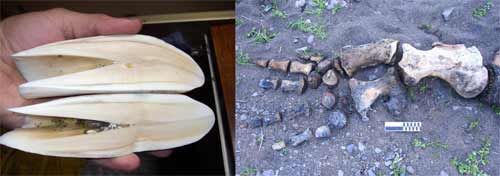The following Journal describing the archaeological activities at the Drobnyye excavation site on Shiashkotan Island has been generously contributed by Mike Etnier.
In addition to the main archaeological work our team conducted at Drobnyye, I was able to spend a bit of time developing, and starting to test, a range of other hypotheses related to the natural resources available to the folks who lived here over the millennia.
Some of the most conspicuous inhabitants of the Kuril Islands today are the foxes.
 A red fox checks out the ¼” screen that we use to recover archaeological materials from excavated sediments. (Photo courtesy of Mike Etnier)
A red fox checks out the ¼” screen that we use to recover archaeological materials from excavated sediments. (Photo courtesy of Mike Etnier)
*A red fox checks out the ¼” screen that we use to recover archaeological materials from excavated sediments. (Photo courtesy of Mike Etnier) *
In addition to wreaking havoc on unsuspecting human campers, they play a major role in the terrestrial ecosystem—especially when it comes to ground nesting birds like puffins, murres, auklets, and fulmars. But their history in the islands is a bit shadowy. It is widely held that they were introduced into the islands, either by the Russian-American Company for fur farming, or perhaps even by the Ainu. For some of the islands, like Ryponkicha, that certainly seems to be the case, since the only foxes we’ve seen there are Arctic foxes (Allopex lagopus), which are unlikely to have gotten there from the far north on their own. But red foxes (Vulpes vulpes) are a different story. For one thing, they are native to Sakhalin Island, Hokkaido, and the Kamchatka Peninsula, so there are "source” populations much closer to the Kurils. And for another, we’ve found red fox bones now in ancient contexts in three locations: Ainu Creek, on Urup Island; Bol’Shoya, on Shumshu Island; and now, after one day of digging, here at Drobnyye, on Shiashkotan.
So how do we test the competing hypotheses about how they may have gotten to Shiashkotan – 1) they got there on their own, 2) they were introduced prehistorically, or 3) they were introduced by the Russian-American Company? And are they mutually exclusive?
One of the ways we can do it, I hope, is to use DNA analysis. If the foxes were introduced recently, their genetic make-up should be identical to that of the source population(s) because they have only been separated a short time. On the other hand, if they got to the islands (only once) in the ancient past, then their genetic make-up should have started to diverge from that of the source population.
I am hopeful that enough research has been conducted on the population genetics of the modern foxes in the Russian Far East to give us some baseline data. Unfortunately, the single piece of ancient bone that we have found so far at Drobnyye is calcined, which destroys the DNA. But another way we could examine this is to look at the genetic make-up of the foxes that are living on the island now. DNA analysis is pretty amazing these days—a single strand of hair can often give you a large enough sample for analysis. But what I discovered while we were at Drobnyye is that there was a massive die-off of foxes this past winter (perhaps related to the diminishing size of the sperm whale carcass, but more on that later). We found 20 dead foxes in the caves around our camp, with 14 in one single cave! Granted, most, or all of these foxes were probably related to each other, which will bias our sample a bit. But a single tooth from each of these individuals will at least give us a start for testing hypotheses about how and when foxes arrived to the different Kuril Islands.
So why did all these foxes die this winter? I suspect it has to do with the sperm whale carcass that is sitting on the beach. Pickings are usually pretty slim for terrestrial mammals on these islands. During the summer there are ground nesting birds that provide an abundant supply of eggs and meat. But the only other main source of food is what washes up on shore, and this can be particularly difficult during the winter (the same would have been generally true for the people living there, except they had two things the foxes do not: boats, and good food storage capabilities).
So imagine that suddenly 50 tons of whale meat washes up on your doorstep (25 meters of whale, at ~2 tons per meter). Then things are great! You’ve got plenty of food. And if you are a tool making island inhabitant, there is a ready supply of ivory (in the form of teeth—see photo below) and good, solid whale bone for making bone tools like harpoons and fish hooks. But like all good things, the whale meat supply must eventually come to an end (in point of fact, when I dug out the flipper bones (see photo below) I found that there was still skin and blubber buried in the sand, after probably 2 years of sitting on the beach. Can you say stinky!?) And fox populations, like that of many predators, often overshoot the supply of food, especially when it comes in unpredictable chunks like this sperm whale. So my guess is that the whale subsidy for the foxes ran out this winter. The arrival of a walrus carcass may have helped (we found some bones on the beach), but the fox population was reduced back down to a "normal” density given the supply of food.
 *Left: A sperm whale tooth cut in half lengthwise, showing the annual growth lines (highlighted in pencil).The oldest (earliest) growth layers are at the tip, and the most recent growth layers line the inside of the pulp cavity. This individual was 25-30 years old.
*
*Left: A sperm whale tooth cut in half lengthwise, showing the annual growth lines (highlighted in pencil).The oldest (earliest) growth layers are at the tip, and the most recent growth layers line the inside of the pulp cavity. This individual was 25-30 years old.
*
Right: Sperm whale flipper bones found buried in the sand at Drobnyye. From right to left are the humerus, radius and ulna, wrist bones (carpals), and the digits. (Photos courtesy of Mike Etnier)
So how would we test this? Might it not be the case that it was a particularly bad winter all across the island, resulting in the collapse of the entire island’s fox population? Or maybe it was due to an outbreak of some disease? If I had had time, I would have investigated fox dens in caves all around the island to see if there were as many recently dead foxes as at Drobnyye, but I did not have time so we may never really know…
The other hypothesis I worked on testing while at Drobnyye was more directly archaeological. On the north side of the site there is a small set of house pits on an isolated rampart along the cliff (see the picture of Ekarma in Shelby Anderson’s Journal). To get to the house pits, you have to cross a ditch 2-3 m deep that looks for all the world like it was carved into the cliff as a way to limit access (a tactic that the Ainu were known to use). So my job for two days was to dig a 1 X 1 m excavation unit in such a way that I would be able to determine whether or not people dug that ditch, either in the recent or the ancient past, or if it was natural. Specific clues that I was looking for were disturbances to the stratigraphy of the sediment and, potentially, cut marks into the bedrock if they had dug deeply enough. We knew ahead of time, based on data from the soil probing, that there were flakes and charcoal in the bottom of the ditch. Not all that surprising, really, considering we knew that people had been living there for quite awhile. But my excavation found that none of the natural stratigraphic markers like volcanic tephra had been disturbed. And, when I had excavated down to bedrock, I found what appears to be an uplifted marine deposit (rounded cobbles cemented into what appears to be beach sand—Bre MacInnes later confirmed from the description that this is what it probably was). Both of these findings support the hypothesis that this ditch is a natural formation, and that the rampart is simply on its way to becoming a sea stack. It is important to note, however, that people still may have used the ditch to help protect the houses out on the rampart!

